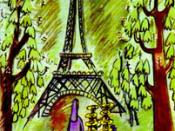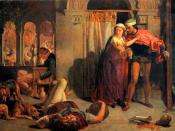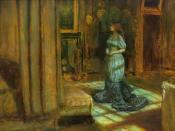PORPHYRO: LOVER OR CONQUERER?
The Eve of St. Agnes
For this paper I will focus on gender implications of romantic love in The Eve of St. Agnes, in agreement with Anne Mellor's theory. Mellor argues that women are not embraced as valued others in romantic poetry, rather they become a narcissistic projection of the lover's self. The Eve of St. Agnes provides many examples of the way a lover views the object of his desires. I will concentrate on both Madeline and especially Porphyro as they progress through the poem with a brief mention of Angela and her role in the piece.
The poem introduces us to Madeline after a brief description of the cold desolation of the outside that follows into the Beadsman's chambers, which is just as cold and joyless. (23) Inside the mood is very festive but Madeline is absorbed with the ritual of the eve of St.
Agnes and moves through reality in a dream-like state, "young virgins might have visions of delight". (47) Obsessed by thoughts of what her dreams may tell her, she ignores all would-be suitors who approach her limiting her choices to dreams. The language used to describe Madeline as she dances is charged with sexuality: "regardless eyes, anxious lips, her breathing quick and short". (65)
Madeline is said to be sweet, beautiful, peerless and pious. She can be said to exhibit some of these qualities when she escorts Angela down the stairs safely, in contrast to Angela's betrayal of Madeline's safety. (196) Angela is the bridge that unites the two lovers and therefore has an integral, although small role. After meeting Porphyro in the Castle he asks of Madeline's whereabouts and Angela tells him of the ritual. (133) The language used as he forms his "stratagem" is connected...



Excellent
Well wriiten, with a great opening to start the paper flowing. As it stands right now, I have no compliants towards you're paper. Transitions and structuring are intact.
Well Done!
3 out of 4 people found this comment useful.